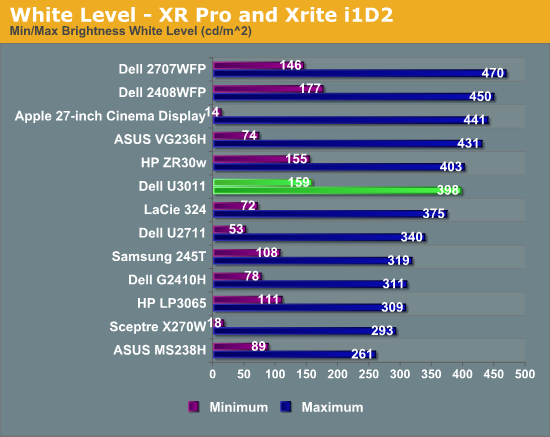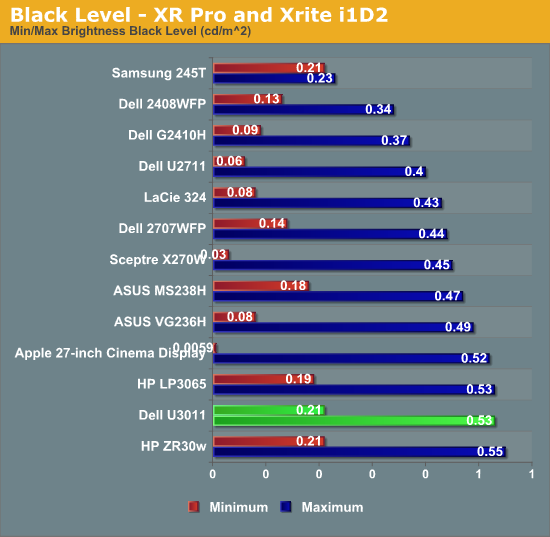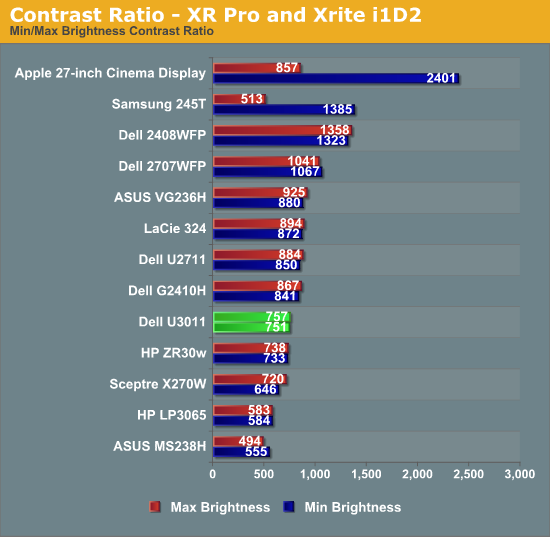Dell U3011 Review: Dell's New 30-inch Flagship
by Brian Klug on January 13, 2011 9:17 PM ESTBrightness and Contrast
For brightness we display white and black levels at maximum and minimum brightness as allowed by the OSD, and divide the two to get contrast. We use the same colorimeter described earlier. In this case, an Xrite i1D2 with ColorEyes Display Pro. For the U3011, dynamic contrast is turned off, contrast is set to maximum on the OSD, and the brightness control is varied across its possible dynamic range.



The brightness dynamic range on the U3011 isn't really amazing. In fact, it was a challenge to get the display to 100 nits for calibration (it required changing contrast and carefully balancing brightness and contrast controls on the OSD). One look at the contrast ratio plot however, and it's obvious what Dell did here - sacrifice dynamic range control for luminance but in so doing keep contrast extremely stable across that range of brightnesses. It's a tradeoff which actually makes a lot of sense, even if it isn't readily apparent when you're playing with the display, especially because the contrast OSD control visually makes a much larger difference than brightness which actually controls the CCFL power. I took a lot more data, but between max brightness and min brightness, contrast is pretty steady at around 750.
It's a bit unfortunate that the IPS in the U3011 isn't a bit more contrasty, especially when advertised is around 1000:1 with dynamic contrast off. Still, not bad.










123 Comments
View All Comments
dimensional - Wednesday, June 1, 2011 - link
This U3011 is large enough to be appropriate for a wall mount. Yet, it seems nobody is asking about the problem with the screws for the mount being way too small and short. Because of the problem, I will need to replace those screws with longer ones just to be able to at least secure the screws most of the way through the holes after installing a thin wall mount onto it. It makes no sense for them to not give you any longer screws so you can mount the huge monitor. Specially after spending a small fortune for the monitor in the first place.ab_ba - Tuesday, February 7, 2012 - link
The review mentions some speckling on this screen. I have an NEC PA271 but the speckling is too annoying. Can anybody comment if it will be better on this screen, or on the HP ZR30?bjnicholls - Monday, November 26, 2012 - link
After reading the reviews for the NEC, HP, and Dell 30" monitors, I decided to give the Dell a try. I currently have an older NEC 3090wqxi that's developing some blotchy gray areas along the upper left edge of the display, and I need a replacement (perhaps letting me get the old NEC repaired if the gray is perhaps a cleanable dust layer).I found a price under $1K from Amazon and decided to give the U3011 a shot. It arrived today and as soon as I tuned it on I was disappointed. On my unit, there was an immediately obvious green shift on the left third of the screen, and that color inconsistency didn't improve at all after the display was warmed up. Nor is it affected by switching between the built-in profiles. Looking at a white screen, the Dell's luminosity is also very inconsistent; my old NEC is still dramatically better. I'm just here to weigh in as a professional graphic designer and photographer. If you care about color accuracy don't bother with the Dell U3011. There's a reason it's half the price of the current NEC PA301w. I suspect that a photographer or designer would be better off spending the price of the U3011 on the smaller 27" NEC PA201w.
Maybe I just got a bad sample, but I very much doubt that the average U3011 is much better and I'm not going to try exchanging it. Despite user reviews and relatively positive articles like this one, I don't believe the Dell U3011 is viable for professional level work. Dell's inclusion of a "calibration" report is really worthless, since it's obviously a spot calibration and doesn't demonstrate any level of consistency for color across the display.